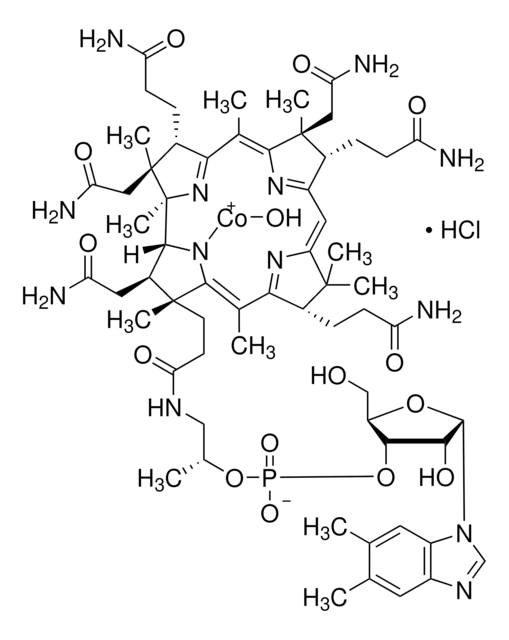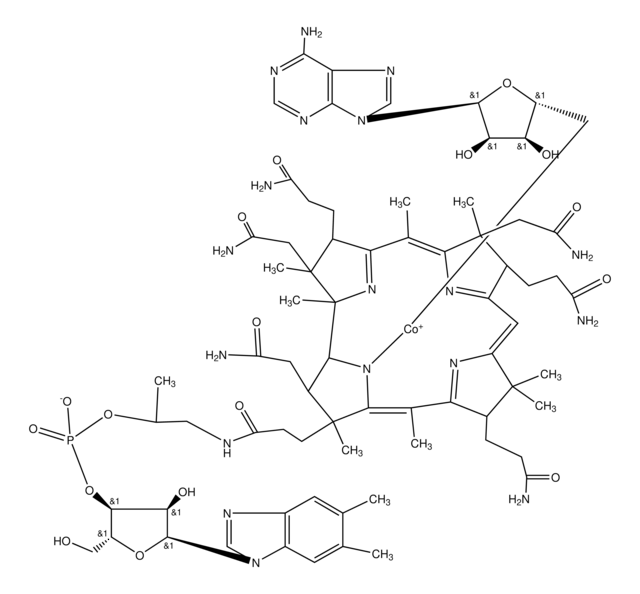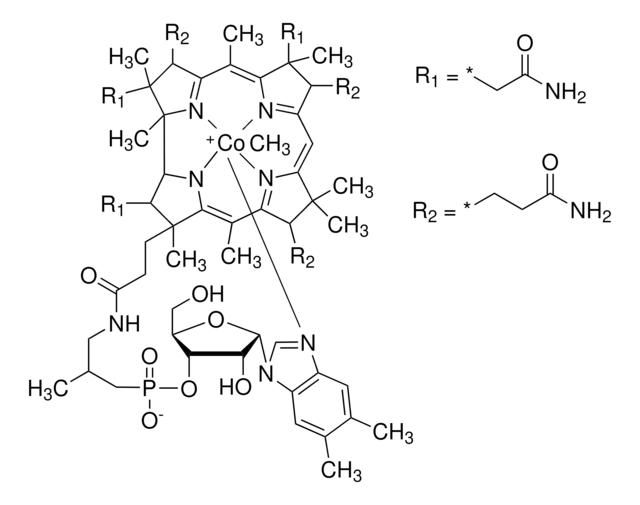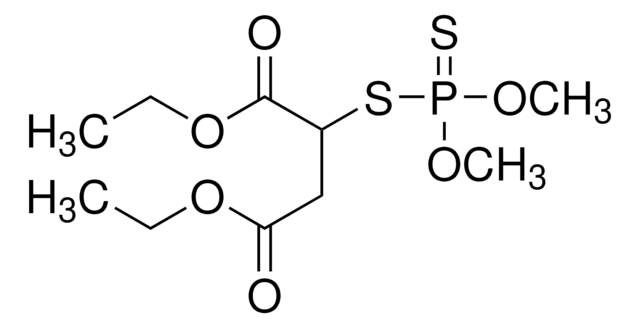Kluczowe dokumenty
95200
Vitamin B12a hydrochloride
≥96% (UV), ≥96% (HPLC)
Synonim(y):
Hydroxocobalamin hydrochloride
About This Item
Polecane produkty
pochodzenie biologiczne
fermentation/recombinant
Poziom jakości
Próba
≥96% (HPLC)
≥96% (UV)
Formularz
powder or crystals
strata
≤12% loss on drying, 20 °C (HV)
kolor
red to dark red
rozpuszczalność
methanol: 10 mg/mL at 20 °C, clear, dark red
temp. przechowywania
2-8°C
ciąg SMILES
Cl.C[C@H](CNC(=O)CC[C@]1(C)[C@@H](CC(N)=O)[C@H]2N([Co+]O)C1=C(C)C3=NC(=CC4=NC(=C(C)C5=N[C@]2(C)[C@@](C)(CC(N)=O)[C@@H]5CCC(N)=O)[C@@](C)(CC(N)=O)[C@@H]4CCC(N)=O)C(C)(C)[C@@H]3CCC(N)=O)OP([O-])(=O)O[C@H]6[C@@H](O)[C@H](O[C@@H]6CO)n7cnc8cc(C)c(C)cc78
InChI
1S/C62H90N13O14P.ClH.Co.H2O/c1-29-20-39-40(21-30(29)2)75(28-70-39)57-52(84)53(41(27-76)87-57)89-90(85,86)88-31(3)26-69-49(83)18-19-59(8)37(22-46(66)80)56-62(11)61(10,25-48(68)82)36(14-17-45(65)79)51(74-62)33(5)55-60(9,24-47(67)81)34(12-15-43(63)77)38(71-55)23-42-58(6,7)35(13-16-44(64)78)50(72-42)32(4)54(59)73-56;;;/h20-21,23,28,31,34-37,41,52-53,56-57,76,84H,12-19,22,24-27H2,1-11H3,(H15,63,64,65,66,67,68,69,71,72,73,74,77,78,79,80,81,82,83,85,86);1H;;1H2/q;;+3;/p-3/t31-,34-,35-,36-,37+,41-,52-,53-,56-,57+,59-,60+,61+,62+;;;/m1.../s1
Klucz InChI
KEHNCSYXYMMUCO-BXSGNKEGSA-K
Szukasz podobnych produktów? Odwiedź Przewodnik dotyczący porównywania produktów
Powiązane kategorie
Zastosowanie
Działania biochem./fizjol.
Inne uwagi
Kod klasy składowania
11 - Combustible Solids
Klasa zagrożenia wodnego (WGK)
WGK 3
Temperatura zapłonu (°F)
Not applicable
Temperatura zapłonu (°C)
Not applicable
Środki ochrony indywidualnej
Eyeshields, Gloves, type N95 (US)
Wybierz jedną z najnowszych wersji:
Masz już ten produkt?
Dokumenty związane z niedawno zakupionymi produktami zostały zamieszczone w Bibliotece dokumentów.
Klienci oglądali również te produkty
Nasz zespół naukowców ma doświadczenie we wszystkich obszarach badań, w tym w naukach przyrodniczych, materiałoznawstwie, syntezie chemicznej, chromatografii, analityce i wielu innych dziedzinach.
Skontaktuj się z zespołem ds. pomocy technicznej






